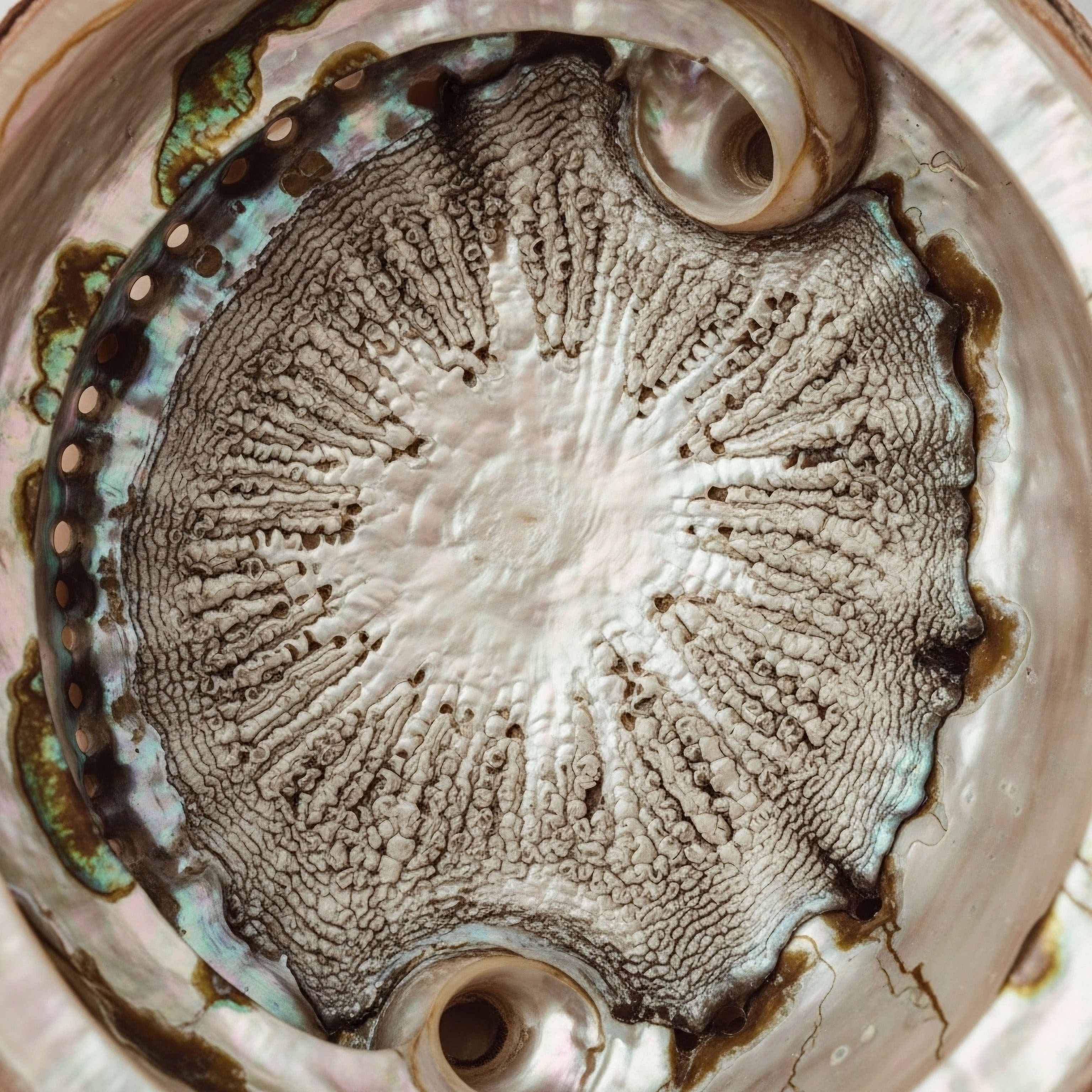

Fundamentals
You may be feeling a persistent sense of fatigue, a subtle shift in your body composition, or a general decline in vitality that you cannot quite pinpoint. These experiences are valid and often point toward the intricate communication network within your body known as the endocrine system.
When we discuss optimizing hormonal health, particularly through testosterone administration, the conversation often centers on dosage. The method of delivery, however, represents a more profound layer of control over your biological systems. The way testosterone enters your bloodstream directly dictates its pattern of availability, creating either a stable, consistent physiological environment or one marked by peaks and valleys. This pattern is the primary determinant of how your body’s metabolic machinery responds.
Think of your metabolic health as a finely tuned ecosystem. It encompasses how your body manages energy, processes fats and sugars, and builds or breaks down tissue. Key indicators, which we call metabolic markers, give us a window into the health of this ecosystem.
These include blood lipids (like HDL and LDL cholesterol), glucose levels, insulin sensitivity, and inflammatory markers. The delivery system for testosterone replacement is akin to the method of irrigation for this ecosystem. A steady, controlled release, like a drip irrigation system, maintains equilibrium.
A sudden, high-volume release, like a weekly flood, can cause significant disruption before settling, impacting everything from your energy levels to your cardiovascular risk profile. Understanding this principle is the first step in moving from a passive recipient of a therapy to an active participant in your own biological recalibration.
The method used to deliver testosterone directly shapes its stability in the bloodstream, which in turn governs its effect on your body’s metabolic health.

The Body’s Internal Dialogue
Your body communicates through hormones. Testosterone is a powerful messenger that instructs cells in your muscles, bones, brain, and fat tissue. The effectiveness of this communication depends on the clarity and consistency of the signal. Different delivery methods create distinct signaling patterns.
Daily applications of transdermal gels or creams aim to mimic the body’s natural diurnal rhythm, providing a relatively stable signal throughout the day. In contrast, intramuscular injections create a large initial surge in testosterone levels, a supraphysiological peak, which then gradually declines over several days. This fluctuation sends a very different set of instructions to your cells compared to a steadier release.
This initial peak from an injection can feel like a surge of energy and well-being, yet the subsequent trough can bring back the very symptoms the therapy aims to alleviate. This cycle has metabolic consequences.
The high concentrations can temporarily alter how your liver processes fats, while the low concentrations may be insufficient to maintain positive effects on muscle mass and insulin sensitivity. Your lived experience of these fluctuations is a direct reflection of the underlying pharmacokinetics, the journey the hormone takes through your body. Recognizing the connection between the delivery method, the hormonal signal pattern, and your metabolic response is foundational to tailoring a protocol that aligns with your unique physiology and wellness goals.

Metabolic Markers What Do They Tell Us
When we refer to metabolic markers, we are looking at a panel of laboratory values that provide a snapshot of your internal health. These are not just numbers on a page; they are direct indicators of how efficiently your body is operating. Understanding what they represent allows you to appreciate how hormonal optimization protocols can influence them.
- Lipid Panel ∞ This measures different types of fats in your blood. LDL cholesterol is often termed “bad” cholesterol, while HDL is the “good” cholesterol that helps clear it away. Triglycerides are another type of fat used for energy. The balance of these lipids is a key predictor of cardiovascular health. Testosterone administration can influence these levels, and the delivery method plays a role in the magnitude and direction of these changes.
- Glycemic Control ∞ This refers to your body’s ability to manage blood sugar. Key markers include fasting glucose and Hemoglobin A1c (HbA1c), which gives an average of your blood sugar over three months. Insulin, a hormone that helps your cells absorb glucose, is also measured to assess insulin sensitivity. Improved insulin sensitivity means your body needs less insulin to do its job, which is a hallmark of good metabolic health.
- Body Composition ∞ While not a blood marker, the ratio of lean muscle mass to adipose (fat) tissue is a critical metabolic indicator. Testosterone powerfully influences this balance, promoting the growth of muscle and potentially reducing fat mass, particularly visceral fat, which is the metabolically active fat stored around your organs.


Intermediate
Advancing beyond foundational concepts requires a detailed examination of the pharmacokinetics associated with each major testosterone delivery system. Pharmacokinetics describes the concentration of a hormone over time, a profile determined by its absorption, distribution, metabolism, and excretion. This profile is the critical link between the chosen therapy and its downstream effects on metabolic markers.
Each method, from intramuscular injections to subcutaneous pellets, generates a unique pharmacokinetic curve, and it is the characteristics of this curve ∞ its peak (Cmax), trough, and area under the curve (AUC) ∞ that drive the specific biological responses in your liver, adipose tissue, and muscle.

Comparing Delivery Systems a Pharmacokinetic Overview
The clinical objective of any hormonal optimization protocol is to restore physiological balance in a way that maximizes benefits while minimizing adverse effects. The choice of delivery system is a primary tool for achieving this. A direct comparison reveals how different methods produce distinct hormonal environments, each with its own set of metabolic implications.
Intramuscular injections of testosterone esters, such as cypionate or enanthate, are a common and effective method. Following an injection, the esterified testosterone is released slowly from the oil depot in the muscle. Enzymes in the bloodstream cleave the ester, liberating free testosterone.
This process results in a significant supraphysiological peak in testosterone levels within 2 to 4 days, followed by a gradual decline over the dosing interval. For a typical 200 mg injection of testosterone cypionate every two weeks, levels can peak well above the normal physiological range before falling, sometimes to borderline-hypogonadal levels, by the end of the cycle. This wide fluctuation can present challenges for maintaining stable metabolic control.
In contrast, transdermal systems, like gels and creams, are designed for daily application. They are absorbed through the skin directly into the bloodstream, bypassing the first-pass metabolism in the liver. This method results in serum testosterone concentrations that rise within a few hours of application and are maintained at a relatively stable level for 24 hours, mimicking the body’s natural daily rhythm.
The avoidance of sharp peaks and deep troughs provides a more consistent hormonal signal to metabolic tissues. Subcutaneous pellets, which are implanted under the skin, offer the most stable, long-term delivery. These crystalline pellets slowly dissolve over three to six months, releasing a consistent dose of testosterone and maintaining serum levels in a steady state within the normal physiological range for an extended period.
The stability of hormone levels achieved with daily transdermal applications or subcutaneous pellets provides a more consistent signal to metabolic tissues compared to the fluctuating levels from intermittent intramuscular injections.

How Do Delivery Methods Impact Lipid Profiles
The influence of testosterone therapy on blood lipids, particularly HDL cholesterol, is a subject of considerable clinical interest. The mechanism of this effect is closely tied to the route of administration. The liver is the primary site of HDL synthesis and catabolism, and it contains an enzyme called hepatic lipase, which breaks down HDL particles.
When androgens are administered orally, they undergo a significant first-pass effect, meaning they are absorbed from the gut and pass through the liver in high concentrations before reaching the systemic circulation. This high hepatic concentration upregulates hepatic lipase activity, leading to a more pronounced reduction in HDL levels.
Parenteral routes of administration, which include intramuscular injections, subcutaneous injections, and transdermal systems, largely bypass this first-pass hepatic metabolism. Because the testosterone does not pass through the liver in a high-concentration bolus, the effect on hepatic lipase and, consequently, on HDL cholesterol, is attenuated. However, differences still exist among these methods.
The supraphysiological peaks generated by intramuscular injections can still exert a greater suppressive effect on HDL than the steadier levels achieved with transdermal gels or subcutaneous pellets. Protocols that maintain testosterone levels within a stable, physiological range tend to have the most neutral or even favorable impact on the overall lipid profile, sometimes improving triglyceride and LDL levels as lean body mass increases.
| Delivery Method | Pharmacokinetic Profile | Typical Impact on HDL Cholesterol | Impact on Insulin Sensitivity |
|---|---|---|---|
| Intramuscular Injections (e.g. Cypionate) | High initial peak (supraphysiological) followed by a steady decline to a trough over 1-2 weeks. | Moderate reduction, linked to peak testosterone concentrations. | Generally positive, but may be affected by fluctuations. |
| Transdermal Gels/Creams | Rapid absorption with stable, physiological levels maintained over a 24-hour period. | Minimal to slight reduction; considered more lipid-neutral. | Consistently positive due to stable hormone levels. |
| Subcutaneous Pellets | Very stable, long-term release maintaining physiological levels for 3-6 months. | Minimal effect; often considered the most lipid-friendly parenteral option. | Strong and stable positive effect due to consistent tissue saturation. |
| Oral Testosterone Undecanoate | Absorbed via the lymphatic system, partially bypassing the liver, but still has a hepatic effect. | Can cause a more significant reduction than parenteral methods due to some hepatic passage. | Positive, but the lipid effects must be monitored closely. |


Academic
A sophisticated understanding of testosterone’s metabolic influence requires an analysis that extends beyond systemic pharmacokinetics to the level of tissue-specific hormone action and enzymatic regulation. The choice of delivery method does more than alter serum hormone concentrations; it fundamentally changes the presentation of testosterone and its metabolites to key metabolic organs, primarily the liver and adipose tissue.
This differential presentation is the central mechanism behind the varied effects on metabolic markers like lipid subfractions, insulin signaling pathways, and adipokine secretion.

Hepatic First-Pass Metabolism versus Parenteral Administration
The most pronounced metabolic divergence between delivery methods arises from the presence or absence of a hepatic first-pass effect. Oral administration of modified androgens, historically 17-alpha-alkylated steroids, resulted in significant hepatotoxicity and profound alterations in the lipid profile.
While modern oral formulations like testosterone undecanoate are absorbed via the intestinal lymphatic system, partially bypassing the liver, a portion still undergoes hepatic metabolism, influencing liver-derived proteins. This route has a demonstrably greater impact on suppressing HDL cholesterol and sex hormone-binding globulin (SHBG) compared to parenteral routes. The suppression of SHBG increases the bioavailability of free testosterone, which has its own set of metabolic consequences.
Parenteral methods ∞ intramuscular, subcutaneous, and transdermal ∞ introduce testosterone directly into the systemic circulation, delivering it to the liver at physiological concentrations, similar to endogenous secretion. This circumvention of the first-pass effect is the primary reason for their more favorable lipid profile. However, even within parenteral methods, the kinetic profile matters.
The supraphysiological concentrations achieved after a large intramuscular injection of a testosterone ester can transiently saturate enzymatic pathways and receptor systems in a way that steady-state delivery from pellets or gels does not. This can lead to more significant, albeit temporary, suppression of HDL and potentially a greater degree of aromatization to estradiol in peripheral tissues, which also has metabolic effects.
The circumvention of first-pass liver metabolism by parenteral testosterone delivery methods is the principal mechanism responsible for their more favorable impact on lipid profiles compared to oral formulations.

The Interplay of Delivery Route Adipose Tissue and Insulin Sensitivity
Testosterone exerts a powerful influence on body composition, favoring the accretion of lean muscle mass and the reduction of adipose tissue, particularly visceral adipose tissue (VAT). VAT is a highly active endocrine organ that secretes inflammatory cytokines and adipokines that contribute to insulin resistance.
The reduction of VAT is a primary mechanism through which testosterone therapy improves insulin sensitivity. The stability of the testosterone signal appears to be important for this process. Steady-state delivery, as achieved with pellets or daily transdermal systems, provides a constant stimulus for adipocyte apoptosis and lipid oxidation in VAT, leading to a sustained improvement in the inflammatory milieu and insulin signaling.
The fluctuating levels from intermittent injections may be less efficient in this regard. The period of low testosterone toward the end of the injection cycle may be insufficient to maintain the suppressive pressure on fat storage pathways. Furthermore, the conversion of testosterone to estradiol via the aromatase enzyme, which is abundant in adipose tissue, is also delivery-dependent.
The high substrate availability following a large injection can lead to a temporary surge in estradiol levels. While estradiol has its own beneficial metabolic roles, an imbalanced testosterone-to-estradiol ratio can interfere with optimal improvements in body composition and insulin sensitivity. Protocols that maintain a stable and physiological balance between these two hormones, often a feature of more consistent delivery methods, tend to produce the most robust and lasting metabolic benefits.
| Mechanism | Intramuscular Injection (e.g. Cypionate) | Transdermal Gel | Subcutaneous Pellet |
|---|---|---|---|
| Hepatic Lipase Regulation | Minimal direct effect, but supraphysiological peaks can transiently increase activity, moderately suppressing HDL. | Very little effect due to stable, physiological concentrations bypassing the liver. Considered HDL-neutral. | Negligible effect, providing the most stable and lipid-friendly profile among common methods. |
| SHBG Suppression | Moderate suppression, influenced by peak androgen levels. | Mild suppression, reflecting stable physiological exposure. | Mild and very stable suppression over the implant duration. |
| Aromatization to Estradiol | Can lead to peaks in estradiol that parallel testosterone peaks, potentially requiring management with an aromatase inhibitor. | Results in a stable, physiological conversion to estradiol, often creating a balanced T/E ratio. | Produces the most stable and predictable T/E ratio over several months. |
| Insulin Receptor Signaling | Improves signaling, but fluctuations can create variability in glycemic control. | Sustained improvement due to consistent hormonal signaling and reduction in visceral adipose tissue. | Strong and sustained improvement due to constant, optimal tissue saturation and VAT reduction. |

What Is the Role of Ancillary Medications
In many male hormone optimization protocols, ancillary medications are used to manage the physiological consequences of testosterone administration. For instance, Anastrozole, an aromatase inhibitor, is prescribed to control the conversion of testosterone to estradiol. The need for such a medication is often linked to the delivery method.
The high testosterone peaks from intramuscular injections can drive a parallel surge in estradiol, leading to an unfavorable hormonal balance and potential side effects. More stable delivery systems, like pellets or daily gels, result in a more predictable and physiological rate of aromatization, often reducing or eliminating the need for an aromatase inhibitor. This has metabolic implications, as estradiol itself plays a crucial role in maintaining insulin sensitivity and bone health. Suppressing it excessively can be counterproductive.
Similarly, agents like Gonadorelin or Enclomiphene are used to maintain the function of the Hypothalamic-Pituitary-Gonadal (HPG) axis and preserve testicular function. The degree of HPG axis suppression is related to the dose and stability of exogenous testosterone.
Understanding the interplay between the primary hormone delivery system and the necessity for these ancillary medications is part of a comprehensive, systems-based approach to metabolic and endocrine health. The goal is to use the most effective delivery method to create a hormonal environment that is as close to a natural, healthy state as possible, thereby optimizing metabolic function for the long term.

References
- Shoskes, J. J. et al. “Pharmacokinetics of testosterone therapies in relation to diurnal variation of serum testosterone levels as men age.” Andrology, vol. 4, no. 4, 2016, pp. 643-51.
- Dobs, A. S. et al. “Pharmacokinetics, efficacy, and safety of a permeation-enhanced testosterone transdermal system in comparison with bi-weekly injections of testosterone enanthate for the treatment of hypogonadal men.” The Journal of Clinical Endocrinology & Metabolism, vol. 84, no. 10, 1999, pp. 3469-78.
- Marbury, T. et al. “Pharmacokinetics of a new testosterone transdermal delivery system, TDS-testosterone in healthy males.” British Journal of Clinical Pharmacology, vol. 61, no. 3, 2006, pp. 279-85.
- “Testosterone.” Wikipedia, Wikimedia Foundation, 2024..
- “Testosterone delivery for men ∞ A review of the available options.” Drug and Therapeutics Bulletin, vol. 54, no. 3, 2016, pp. 31-34.

Reflection

Calibrating Your Internal Systems
The information presented here provides a map of the biological terrain you are navigating. It details the mechanics of different hormonal protocols and their metabolic consequences. This knowledge is a powerful tool, shifting your perspective from one of simply treating symptoms to one of systematically recalibrating your body’s internal communication network.
The path forward involves a partnership between this clinical understanding and your own lived experience. How do you feel on a given protocol? What do your metabolic markers show over time? The answers to these questions are the data points that matter most.
Your unique physiology, lifestyle, and health goals will determine which approach is most appropriate for you. This journey is about discovering the specific inputs your system needs to function optimally. The science provides the framework, but your personal experience provides the essential context.
Use this knowledge to engage in a more informed dialogue with your healthcare provider, to ask more precise questions, and to become an active architect of your own well-being. The ultimate goal is to create a state of sustained vitality, one where your internal systems operate with quiet efficiency, allowing you to function at your full potential.



